Nintendo's Development Secrets, Cloud Gaming & new Killer NIC - GDC '09
by Anand Lal Shimpi & Derek Wilson on March 26, 2009 12:00 AM EST- Posted in
- Trade Shows
This is my first GDC. It’s the Game Developers Conference. I’m not a game developer, but I’m not a regular developer either and I go to the Intel Developers Forum all the time. When Derek went last year he said that there was just too much show, and that next time he’d want me to come to help out. I obliged. Trips out to California always end up being useful in one way or another.
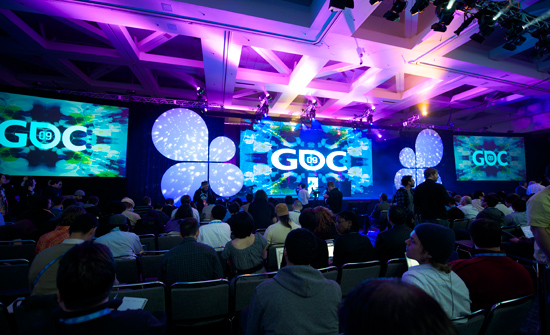
As with all conferences, this one started with a keynote. And not just any keynote. The 2009 Game Developers Conference started with a keynote from the president of Nintendo: Saturo Iwata.
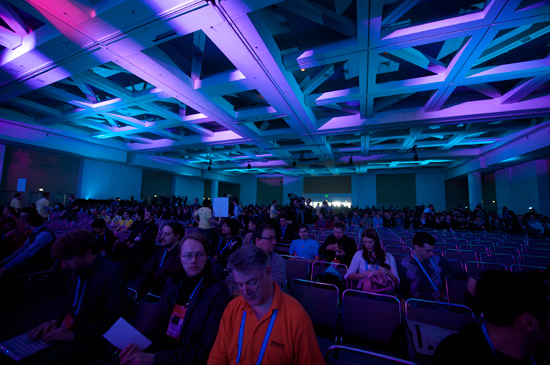
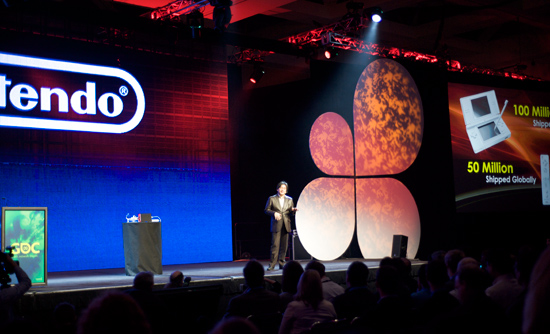
Iwata on stage
I’d never been to a Nintendo keynote before, nor had I ever heard Iwata speak. He spoke with a very mild lisp but was very calm, collected and confident in his delivery. I don’t really know how else to describe it other than that he spoke the way you’d expect the president of Nintendo to speak.
Nintendo has had a huge impact on the video game business in the US and around the world, largely due to the success of the Wii. The Wii is extremely popular, but Iwata really put it in perspective. Nintendo has shipped over 50 million Wii consoles since its launch in 2006. That’s the fastest ramp rate of any console. The Wii Balance Board, the peripheral that comes with Wii Fit, has sold around 15 million units. That in itself is nearly as many units shipped as Sony’s PlayStation 3.
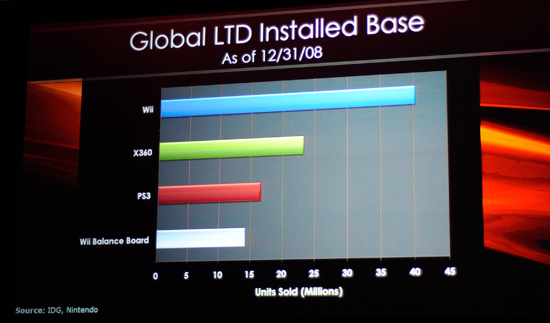
Over 40M consoles shipped by the end of last year. 50 million total since then.
The graph below shows total US video game market growth for an eight year period starting in 2001. The bars represent total video game hardware, software and accessory sales for each year in the US alone.
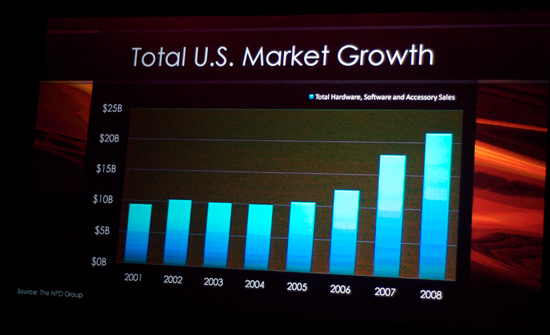
In 2008 the US video game industry broke $20B. That’s pretty impressive. Now look at what percentage of that growth was solely because of Nintendo:
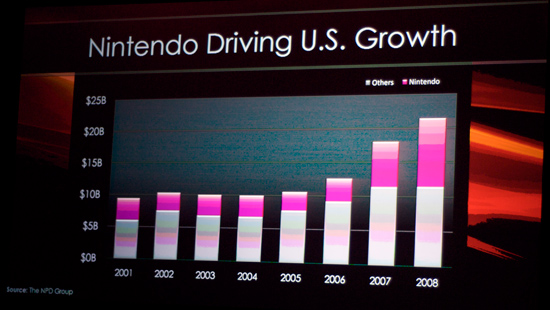
The pink sections of the bars are Nintendo related sales alone
Nintendo accounted for nearly $12B of the $22B US video game industry in 2008. There’s no other way to put it, Nintendo is single handedly driving growth in the US game industry - largely due to the Wii.
The trend is the same in the UK, Germany and France:
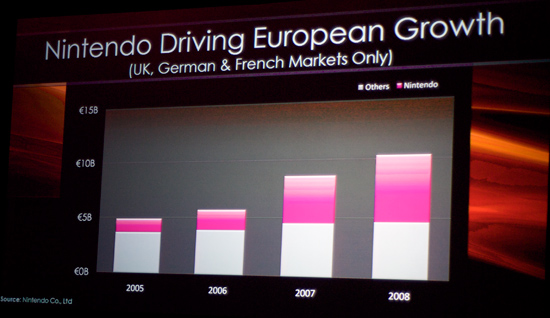
Around half of all video game related sales in those countries last year was because of Nintendo. The numbers are just ridiculous. Cute cuddly video game characters aside, Nintendo is as colossal of a market force as companies like Intel, Microsoft and Google in their respective industries. Nintendo’s size in itself shouldn’t be surprising, but when characterized in terms of the entire video game market it’s shocking.
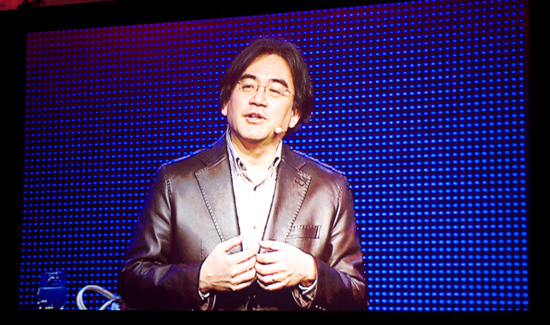
This next part was cool. Iwata took us through how goes about designing games. For those of you who don’t know, Miyamoto is the creator of Mario, Zelda, Pikmin, Nintendogs and some of Nintendo’s other extremely popular franchises. Given that Iwata was speaking to an audience of game developers, choosing to speak about Miyamoto’s approach to game design made a lot of sense. But to me, it was just awesome to hear about how someone who is great at his craft goes about his work. I love stories like that.
Let’s get started.










38 Comments
View All Comments
wilkinb - Thursday, March 26, 2009 - link
in woW latency can be a big deal...Stop casts in pvp or boss fights are a lot harder when you have high ping times and the cast times are short....
Also timing CD's right time not be on shot...
Sure if you are just doing easy content or dont care about arenas then it doesnt matter... but the same can be said about FPS...
Also people keep saying wow isnt prashically intensive.. this again is true when you stand by your self... when you are on say a WG battle ground with say 160 other players adn all their spell effects... there are a lot of polygons... It runs slower then crysis for example.
MOO's have to deal with more scaling issues then FPS.
MMO's have the issue f
wilkinb - Thursday, March 26, 2009 - link
no idea what happned to some of that text :(wtb edit.
randomname - Thursday, March 26, 2009 - link
"I'm sure the video latency will be at least a second."In Dean Takahashi's article:
"A packet can make an entire round trip in 80 milliseconds, a very short amount of time compared to other Internet traffic that travels through hardware that either compresses or decompresses the data."
I'm assuming that 80 ms has all the essential stages included. Which would be supported by Anand's claim that Bioshock felt like Bioshock.
Nevertheless, lag, reliability and bandwidth are probably the only obstacles here. All of which can be further improved. Bandwidth-wise, once you get to Blu-Ray -quality 40/48 Mbps, or at least when you get to 1080p60 4:4:4 -quality, additional bandwidth won't get you anything, really. On the server side, you would only have to buy a fraction of the number of consoles/computing hardware compared to every user buying one. And if you can do it with games, you can do it with all programs and media.
SSDMaster - Thursday, March 26, 2009 - link
80ms? Okay, wonderful. I have to wait .08 Seconds till I can move my cross hairs over someone's head which is only going to be in that specific location for another .02 Seconds.FPS's are too fast paced for this... Especially UT 2004 types.
Maybe you could play a horrendously slow paced FPS like Halo or something.
Also, the US internet backbone just cannot handle this kind of streaming. Comcast gives me a 30mb connection for about 7 minutes. Then they cap it back to whatever I "really" have, which is a 6mb connection. Which "should" be enough unless everyone starts using onLive... Then I'm sure Comcast won't even be able to give me 6mb.
My last point. Internet packets don't always arrive on time or in order, its not like you have this one internet (pipe) to your computer. Think of a stream full of rocks, and your packets (water) are taking tons of different paths, all around these rocks.
That's really not a good enough illustration but I think you guys get the point. If you have a router between you and onLive server's which is bogged down but still working; then your connections going to suck. Not all routers prioritize packets.
Modeverything - Thursday, March 26, 2009 - link
I think one solution to this could be to use UDP instead of TCP.Today's networks are not the ones of a decade ago when packet verification was needed. Packets rarely get lost anymore, and if you lose a single packet, big deal, you probably won't notice anyway.
If OnLive were setup to use UDP transmission, I think it would work.
overzealot - Friday, March 27, 2009 - link
It's a latency-critical app, they're definately going to use UDP, possibly with a layer of RTP(or similar protocol)andrihb - Thursday, March 26, 2009 - link
Think of them as a series of...Calin - Thursday, March 26, 2009 - link
Latency might not be a big deal in World of Warcraft - but remember that people balk at the idea of TFT monitors showing the image from 3-5 frames back - that's less than a tenth of a second. If you're talking about Internet-enabled gaming, you should consider the ping response time you get from a server when you're streaming something (from the same server, probably). Let's say ping to a game server while streaming high quality video.The bandwidth really needs to increase for this, and the latency needs to go down.
As for adaptive quality based on usable bandwidth, you don't know when you're reaching your bandwidth, you only know when you're surpassing it, so that makes the game stutter (too low a bandwidth = lost packets), then go sometime in low quality mode, and then go again in high quality mode. For high quality games, the server would need the equivalent of a high-performance recent-generation video card and CPU for every gamer out there, and the hardware or CPU to compress that stream (video and audio)
It will probably happen, but it's a long time into future